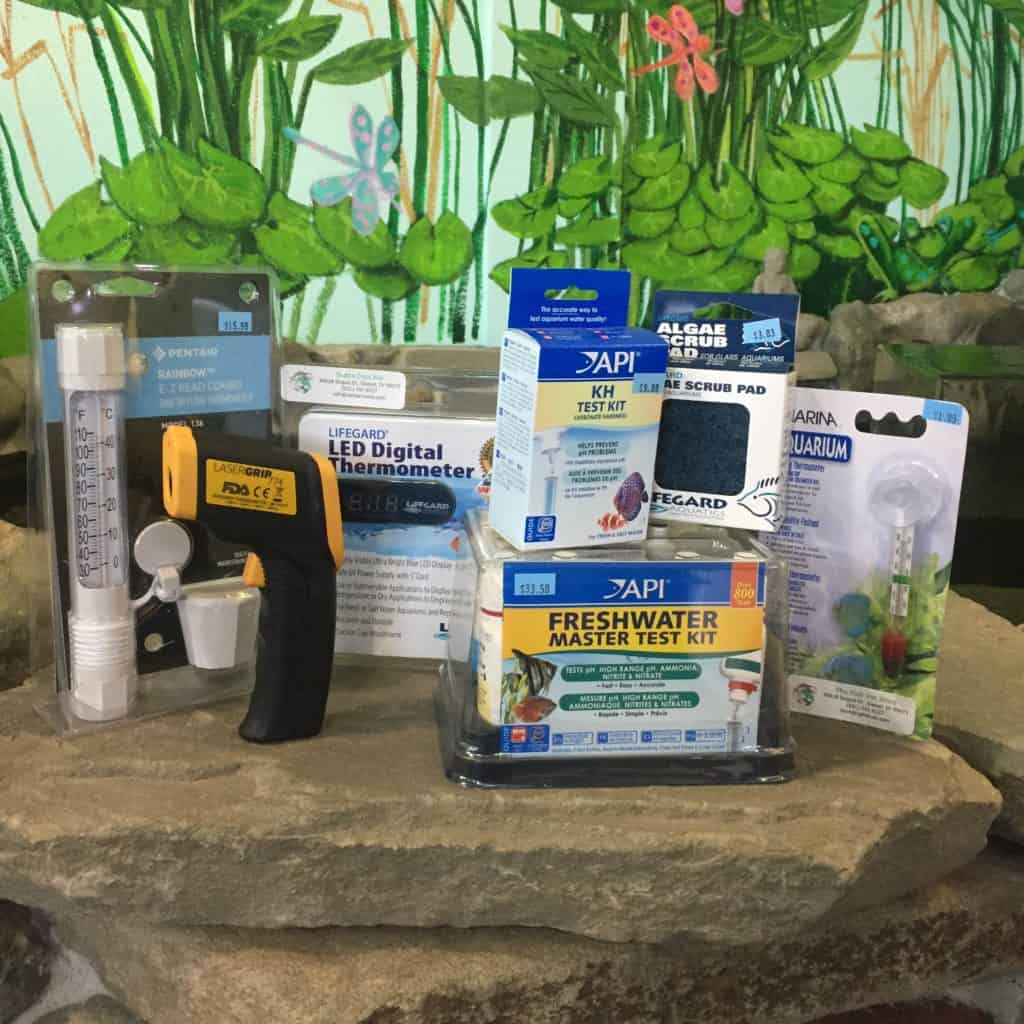** This post contains affiliate links that pays us a small percentage for your purchases from our recommendations. **
Water quality is the #1 factor in influencing fish health. Maintaining your fish water quality is the most important thing you can do for your pet fish. By testing it regularly with a reliable test kit, you can significantly increase your fishes’ quality of life, no matter the species.
Fish Water Quality: The Nitrogen Cycle
In a fish tank, a fish’s primary waste is ammonia. Ammonia is produced by the breakdown of protein, the main staple of most fishes’ diets. Ammonia is excreted out primary through the gills and less so through the urinary tract. Ammonia is highly toxic to fish, causing death and increased secondary illness, so it is converted, through nitrogen-fixing bacteria, into nitrite. Now, nitrite can be just as bad as ammonia. Methemoglobinemia, or “Brown Blood Disease,” is caused by a build-up of nitrite. Nitrite can bind to hemoglobin in the blood and outcompete oxygen. This causes a brown coloration and the fish will asphyxiate from lack of oxygen. Thankfully, more nitrogen-fixing bacteria convert nitrite into the final nitrate. Nitrate is safe for fish at low levels, but at higher levels, and depending on the fish species’ tolerance, can cause the same issues as high ammonia. Nitrate is removed from the system by aquatic plants or water changes.
In established systems (over 2 months old with no new fish or equipment), your ammonia should be ZERO. Most low readings indicate your filtration capacity is inadequate or secondary to overfeeding. The highest reading acceptable on our test kit is 0.1 mg/L. The traditional API freshwater master test kit ranges between 0-0.25, so attaining a 0.1 reading will not occur. Due to the broad range of values, a 0.25 reading may be a false positive (reporting a higher value than what is actually present).
There are many commercial additives for removing ammonia from your tank prior to the nitrogen cycle. Some can cause ammonia test kits to read falsely high. These additives are short-term solutions that should only be used with significant health issues. They are not a long term maintenance solution. You MUST establish your biological filtration (good bacteria) for long-term fish health. If you have persistent ammonia in your tank, consider the following solutions:
- Is your filtration adequate? Tanks with higher bioloads (size and number of fish) will require more than standard filtration. When in doubt, always filter more than you should.
- Are you feeding appropriately? Remember, ammonia is produced from breakdown of protein in a fish’s diet. More food = more ammonia. Check your protein levels! For more information on fish diets, read this.
- Are you doing lots of water changes? If you are constantly removing ammonia, your nitrogen-fixing bacteria will never become established.
- Is there ammonia in your source water? Check the level coming out of your tap or well to make sure! You may need to consider another water source.
There are also commercial additives that will “quick start” your nitrogen cycle. Sorry folks, but these are a complete scam. With the exception of one product that slightly shortened the establishment of your nitrogen cycle, it will take 4-6 weeks MINIMUM to get your tank properly cycled. By “cycled,” we mean the establishment of a complete nitrogen cycle with ammonia being converted all the way to nitrate. We recommend starting with very few fish and monitor your ammonia, nitrite and nitrate levels carefully!
Fish Water Quality: pH and kH
Many of our clients purchase “master” test kits which include: ammonia, nitrite, nitrate, low and high pH. This is a great collection of parameters to start with, but what about kH?
For those of you unfamiliar with kH, kH measures the buffering capacity of your water. Buffers bind to free hydrogen ions (H+) and keep them out of solution. Since your pH is a direct measure of [H+] in your system, kH directly impacts pH. And remember that high [H+] = more acidic and low [H+] = more basic.
(For those of you who are confusing this with gH, or total hardness: gH measures the amount of calcium and magnesium in your water. Although this may be a component of your kH, they are separate parameters entirely.)
So, if your kH levels are too low, all the H+ your fish discharge due to metabolic processes can build up and crash your pH. Adequate kH levels will keep your pH consistent throughout the day, regardless of what your fish and filters are doing. Knowing your tanks kH is an essential component to any fish keeper’s database. There are simple tests available that will make your testing a true “master kit.”
A kH value of >50 mg/L is adequate, but >100 mg/L is better.
If your tank kH is low, test your source water kH. Some city and well systems have low kH coming in and will need buffers to be manually added to your system to maintain adequate levels. Keep an eye on your pH when manually adding buffers in order to make sure your pH will not change too much. Slow and steady is the goal for any pH changes.

